Hither Came Conan: David C. Smith on “Pool of the Black One”
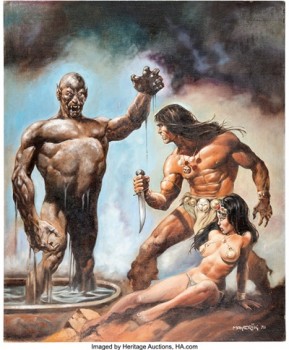
Welcome back to the latest installment of Hither Came Conan, where a leading Robert E. Howard expert (and me) examine one of the original Conan stories each week, highlighting what’s best. Up today, it’s author and Howard literary biographer David C. Smith. I reda Oron long before I discovered Conan. Read on!
By mid-1932, when Robert E. Howard wrote “The Pool of the Black One,” his tenth story to feature Conan the Cimmerian, he was well past the journeyman phase of his career. The very successful Sailor Costigan boxing stories had been appearing regularly in Fight Stories since the summer of 1929; Howard was becoming one of the prize contributors to Oriental Stories with his historical fiction set during the Crusades; and his stories featuring King Kull, Solomon Kane, and Bran Mak Morn and the ancient Picts had earned him star status as one of the premier contributors to Weird Tales.
Of the first four Conan stories written in early 1932, Farnsworth Wright had accepted for publication “The Phoenix on the Sword” and “The Tower of the Elephant.” These stories, together with the two unsold manuscripts — “The Frost Giant’s Daughter” and “The God in the Bowl” — make clear that Howard was finding his way with the character and with his Hyborian Age setting. Conan is introduced in “The Phoenix on the Sword” as the regal king of Aquilonia; in the unsold second story, “The Frost Giant’s Daughter,” he is a lustful young man eager to rape a beautiful goddess. The weird and imaginative “The Tower of the Elephant” takes place in a haunted tower, introduces a space alien trapped by the magic of an evil sorcerer, and concludes with a comically dark turn equal to any of Clark Ashton Smith’s stories. “The God in the Bowl,” on the other hand, is essentially a murder-mystery.
Conan the Cimmerian as we have come to recognize him begins to take shape in the next two stories, both of them masterpieces: the epic “The Scarlet Citadel” and the dreamy — and nightmarish — “Queen of the Black Coast.” But “Black Colossus,” the seventh story of the series, marks a turning point. Patrice Louinet notes that “Black Colossus” convinced Howard “that quality and strong characterization were not the essential elements when it came to selling a Conan story.” He identifies the next three — “Shadows in the Moonlight,” “The Slithering Shadow,” and “The Pool of the Black One”—as routine. All “feature scantily clad female characters, irresistibly attracted to the Cimmerian,” and “all three sold immediately.”
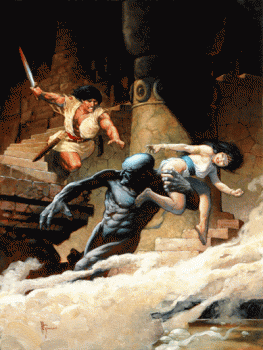
Depending on whatever inspired him, Howard consistently used the Conan stories to explore various ideas, express certain moods, or, as he told Novalyne Price, simply get a paycheck. “The Scarlet Citadel,” “The Hour of the Dragon,” and “Beyond the Black River” are proudly dramatic and epical. “The Slithering Shadow” and “Red Nails” illustrate Howard’s philosophy of civilized society cascading into decadence. “The Tower of the Elephant,” “Queen of the Black Coast,” “Rogues in the House,” and “The Devil in Iron,” start out as more or less conventional adventure stories before suddenly taking a sharp turn into something dangerous or truly weird. “The Pool of the Black One” is one of these.
As usual with Howard, the story opens strong. Conan appears abruptly, hoisting himself over the rail of a carrack captained by the Freebooter Zaporavo. We are introduced immediately to the captain’s voluptuous, essentially unclothed consort, the beautiful Sancha, and plunged, along with Conan, into the wolf pack world of these pirates and marauders. As must any inductee into prison life or a powerful gang, Conan is required to demonstrate where he fits into the pecking order and does so in short order by killing the toughest man onboard with one “sledgelike” tap on the jaw that breaks the brute’s neck. The dead man becomes dinner for the sharks while Conan takes his place among the crew, who immediately recognize his leadership skills. Conan knows what he wants but bides his time, having no immediate quarrel with Zaporavo and therefore having no cause to challenge him for captaincy of the ship.
After many weeks sailing westward, the Wastrel makes land on a gentle beach. Zaporavo, Conan, and the other pirates go ashore, with Sancha ordered to remain onboard. Soon enough, Zaporavo heads inland on his own, his imagination filled with dreams of hidden treasure, and Conan shadows him. Sancha strips down to no more than she was born with and swims ashore to follow them both.
Inland, away from the crew, she finds her lover dead with a fresh wound in his chest—dead by the hand of Conan, we soon learn, who engaged Zaporavo here as he could not onboard the carrack. Sancha is then taken captive by an unnaturally tall black creature. Conan himself sights another of the creatures and follows it and another victim, one of the pirates, to a fortress made of “green shining walls and towers” that blends in perfectly with the vegetation around it.
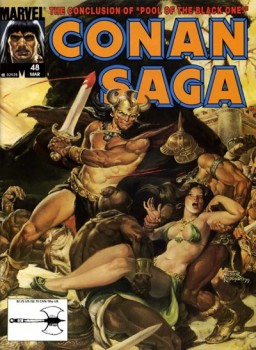
Howard in his fiction enjoys describing architecture, tunnels, secret passages, and structures with many rooms—metaphors for whatever twists, turns, and dubious situations we become involved with in life—and here, as Conan explores the enclosed fortress, he reaches a balcony and looks down upon a “swarded court” in which a band of the tall, naked, black creatures “made like men” squat naked around a dark green pool. One of them plays on a “pipelike thing” that causes the abducted young sailor to twitch and jerk violently.
Conan senses “a cosmic vileness transcending mere human degeneracy” and is shocked “at the cosmic obscenity of these beings which could drag to light the abysmal secrets that sleep in the unfathomed darkness of the human soul.” The boy’s torturer then picks up the young man and holds him under the water of the green pool.
Conan ducks out of the way, afraid that he will be seen, but makes his way to the green pool once the strange tall men “file away across the green slopes, in the direction from which they had come.” There is no sign of the dead young man but, in a wall of court, Conan sees miniature statues set upon ledges, incredibly lifelike figurines that feel like petrified bone. They represent the many peoples of the world, some of them displaying “racial types long vanished and forgotten.” We understand that these were once living people who have been turned by the water in the pool into dead miniatures, like shrunken heads.
Now the giant carrying Sancha arrives. He grasps her by her neck and crotch to drop her into the green pool. Conan rushes to the rescue, ducking to avoid the giant’s taloned hands and driving his sword through the creature’s groin. He and Sancha then confront the rest of the black men, who are returning with the Freebooters under their arms, the pirates sleepy from the effects of golden fruit they found on the island.
Conan draws the attention of the giants, who chase him and drop the crew members onto the sward. Sancha runs to the pirates, shakes them awake, and shoves their swords into their hands. As the Zingaran pirates join the fray, Conan fights for his life and confronts one of the giants, who cries out inhumanly, “the only sound made by a black during the entire fight.” The creature jumps above the pool. The green waters rush up to meet him, “enveloping him in a green volcano,” and with a deafening noise, “the great column of water reared and reared, blossoming at the crest with a great crown of foam.” Conan urges the surviving pirates to hurry back to the ship: “That fountain is going to burst in a moment—”
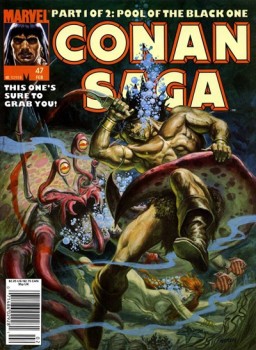
Like a gigantic serpent, the great column of water follows them, rising and falling as it flows over the slopes of the island. The buccaneers make it to the shore, jump into their boats, and row for the carrack—just as the great green river bursts through the fringe of trees lining the beach. Even as Conan, Sancha, and the crew get under sail, “like a tongue of emerald flame, a ribbon licked out on the water futilely,” nearly reaches the Wastrel, but then advances no farther.
After that breathless chase, Conan, running with blood, with gore clotting his black mane and an ear half torn off, lets go with a gusty laugh in sheer exuberance of “muscular might.” He has a crew and a ship and a beautiful woman: “Come here, girl, and give me a kiss.”
“You can think of kisses at a time like this?” Sancha asks him, meaning kisses and whatever those kisses may lead to.
“I think of Life!” Conan roars, and steers his crew onward to plunder and further adventures.
Life! “The Pool of the Black One” is Howard having a good time. As goofy as it gets halfway through, it is not at all out of place among the outlandish adventure stories that appeared regularly in Weird Tales at that time. But this story is emphatically about physicality, flesh, and sex. Indeed, it is overripe in this regard; certainly there’s no doubting the obvious symbolism of that roaring column of water rising from the pool that blossoms at the crest “with a great crown of foam” and keeps lengthening and lengthening, chasing Conan and Sancha and the crew across the island and back to the safety of the Wastrel. Farnsworth Wright, who enjoyed limericks, saucy double-entendres, and similar off-color witticisms, must have chuckled at that one. And vibrant sensuality is constant throughout, not just in regard to the sexy Sancha but also in the reminders of the contoured hills and valleys of the island described as if the landscape were Sancha’s own voluptuous body. Then there is the petrified bone and all of the columns and towers set erect in the tropic warmth. It’s as if we are enjoying the overripe lushness of a Frazetta cartoon giantess lolling out in the open on a bright afternoon.
Howard must have been in a good mood when he wrote “The Pool of the Black One.” He reprises some of his favored story elements — “perversions of evolutionary development” and examples of life forms long vanished, twisted architecture laid out like a world determined to play games with us, and certainly the swordfight between two strong, determined men. The scenes of violence are as exact and clinical as provocative lines of verse, as we expect from Howard.
A further motif: The vivid description of the Zingaran youth tortured into dancing erotically and spasmodically contrasts despicable, subhuman degeneracy and lasciviousness with the otherwise lively sensuality and strength that Conan and Sancha exhibit: “It was as if the mute tune of the pipes grasped the boy’s inmost soul with salacious fingers and with brutal torture wrung from it every involuntary expression of secret passion. It was a convulsion of obscenity, a spasm of lasciviousness—an exudation of secret hungers framed by compulsion: desire without pleasure, pain mated awfully to lust. It was like watching a soul stripped naked, and all its dark and unmentionable secrets laid bare.”
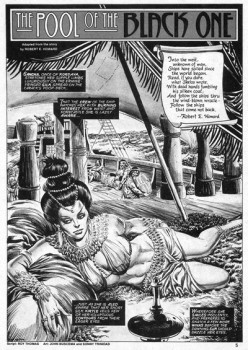
Howard uses such overwrought language when victims in his fantasies are tortured by sorcerers or wicked women, human monsters who recognize no boundaries, as in “The People of the Black Circle” and “The Slithering Shadow”—natural human desire and eroticism twisted into something vicious, degenerate, and soulless. Such depravity is an expression of evil for Howard.
The obscene piping reminds us of another motif of Howard’s, the elemental importance of sound, the effects of which often figure as a plot device or important element in his fantasy stories. In “The Pool of the Black One,” it is the inhuman cry that the giant black man releases just before jumping into the pool — hence, the title of the story: “the black wheeled and bounded high.
For a flash of an instant they saw him poised in midair above the pool; then with an earth-shaking roar, the green waters rose and rushed up to meet him, enveloping him in a green volcano.” Then the column of green water starts its long rise from who knows how deep in the earth and begins chasing the island’s intruders back to the shoreline.
In our age of well-manicured fantasy fiction, the abruptness and muscularity of an adventure story such as this one speaks for itself. It’s a dream; many of Howard’s best passages and stories have the staying power of dreams we can’t quite disregard or forget. That’s what a powerful writer can do, and he had the gift. “The Pool of the Black One” doesn’t have much of a plot, but dreams and nightmares don’t require plots; all they require is vivid imagery and emotional involvement. Here, once again, Howard delivers both.
The quotations of Patrice Louinet are taken from “Hyborian Genesis: Notes on the Creation of the Conan Stories,” in The Coming of Conan the Cimmerian, Ballantine Books, 2003.
From the Dusty Scrolls (Editor comments)
While Olivia bravely rescued Conan in “Iron Shadows in the Moonlight,” Sancha is purely a lawn ornament. Which is reflected in many of the illustrations. She does get shaken into some fortitude and awakens the pirates, gives them their swords and sends them towards Conan, though. Mostly, she’s there to be scantily clad, or naked.
This is the second of Howard’s ‘purely pirate’ stories about Conan, after “Queen of the Black Coast.” In L. Sprague de Camp’s ordering (as well as William Galen Gray’s), it is followed by another sea-faring tale, Conan the Buccaneer. I seem to like that pastiche more than most folks I know.
Conan follows Zaporavo into the woods specifically to kill him. Conan knows he’s not well-enough established to challenge the captain openly for leadership of the crew. So, he trails him into the forest, makes it clear that he is there to kill him and strides towards him, sword in hand, and then vanquishes him. Zaporavo did have the opportunity to defend himself, but it’s cold-blooded murder. This doesn’t seem to get discussed much. Any more than Conan agreeing to murder a man (Nabonidus) so he can be freed from jail. The moral and ethical issues involved seem worthy of more study.
It appeared in the October, 1933 Weird Tales: only one month after “The Slithering Shadow” The atypical Margaret Brundage cover was for “The Vampire Master” by Hugh Davidson (Edmond Hamilton). Among the other stories in that issue were ones by Clark Ashton Smith, Frank Belknap Long, and Seabury Quinn, as well as a reprint of Lovecraft’s “The Festival.”
With Roy Thomas writing and John Buscema inking (I love that combo), Savage Tales of Conan adapted “Pool of the Black One” in issues 22 and 23.
Rescuing Sancha and killing the leader of the Black Ones is one of the more difficult quests in the ‘introductory’ portion (levels 1-20 on the island of Tortage) in the Age of Conan MMO (which I like).
Prior Posts in the Series:
Here Comes Conan!
The Best Conan Story Written by REH Was…?
Bobby Derie on “The Phoenix in the Sword”
Fletcher Vredenburgh on “The Frost Giant’s Daughter”
Ruminations on “The Phoenix on the Sword”
Jason M Waltz on “The Tower of the Elephant”
John C. Hocking on “The Scarlet Citadel”
Morgan Holmes on “Iron Shadows in the Moon”
Up next week, Dave Hardy’s look at “Vale of the Lost Women.”
David C. Smith is the author or coauthor of two dozen novels. His epic fantasy trilogy The Fall of the First World has been reprinted by Wildside Press, and he is now revising his sword-and-sorcery series featuring the character Oron to be reprinted by Pulp Hero Press.
 Bob Byrne’s ‘A (Black) Gat in the Hand’ was a regular Monday morning hardboiled pulp column from May through December, 2018.
Bob Byrne’s ‘A (Black) Gat in the Hand’ was a regular Monday morning hardboiled pulp column from May through December, 2018.
His ‘The Public Life of Sherlock Holmes’ column ran every Monday morning at Black Gate from March, 2014 through March, 2017 (still making an occasional return appearance!).
He also organized Black Gate’s award-nominated ‘Discovering Robert E. Howard’ series.
He is a member of the Praed Street Irregulars, founded www.SolarPons.com (the only website dedicated to the ‘Sherlock Holmes of Praed Street’) and blogs about Holmes and other mystery matters at Almost Holmes.
He has contributed stories to The MX Book of New Sherlock Holmes Stories – Parts III, IV, V and VI.
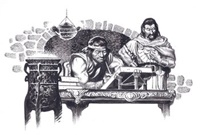
Love this series. And Smith’s bio of Howard is a classic. Highly recommended.
Indeed, kudos to Bob, John and BG for this idea! Having first encountered Howard (in The Spell of Seven, I think) during my own Golden Age of SF/F, I’d long relegated him to second-tier status, not matching the significance of the field’s more recent ‘serious writers’…a mistake that this series is helping rectify. I’ve already started digging in the basement for my old paperbacks and looking forward to rereading REH in a new light…Thank you!
“The Del Rey cover for ‘The Coming of Conan.’ This is the volume that made me a Conan fan.” I assume Bob and not David wrote that caption. It would be quite strange if someone who wrote sword and sorcery in the ’70s didn’t become a Conan fan until 10 years ago.
My reaction to the middle-period Conan stories has always been kind of “meh” (not that that term existed yet when I first read them). They’re Howard, so they’re reasonably good Conan, as opposed to pastiche, which is suspect until proven otherwise (good ones do exist). Smith does not persuade me to think better of this one. It’s a rollicking roller-coaster ride, and once it’s over you might want to ride again, but there’s nothing about it that says to you “this is a really special roller-coaster.”
But I’m glad to know Conan managed to find a decent hand with a needle to stitch of that ear. He must have, since there’s no report of it hanging off or being truncated in later tales.
While not one of my favourites I have still always enjoyed Pool of the Black one. Alas don’t think David quite sold it as The Conan Story, well to me at least.
On a side note I semi ruined this story for myself through making an arbitrary mental reference to the small figures as “hey them tall black humanoids enjoy wargaming”. Add a bit or a parallel to the old Wormy comic strip in 1980’s era Dragon magazines and there we have it, silliness in the background of what otherwise is a serious S&S tale.
Dave – Yeah, I need to remember the captions are going on pics for other people’s posts. I’m used to doing my own…
I saw that color print for sale online, recently. That’s tempting…
On the one hand, this was never one of my favorite Conan tales.
But as I re-read it (one I haven’t done so very often for), I remember thinking that with the physical layout of the Black Ones’ castle/whatever, it was very different than any other Conan story.
And I liked that part.
And I barely fought down the urge to count how many times Howard used ‘sward.’ I mean, it’s everywhere!
I’m looking forward to seeing David once again at Howard Days. Perhaps I’ll have to give him what-for on his unpersuasive presentation of THIS IS THE BEST CONAN TALE. While the story is fun and all, Bob summed it best: Swards together!